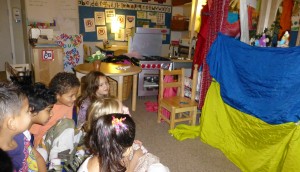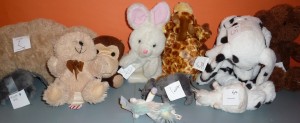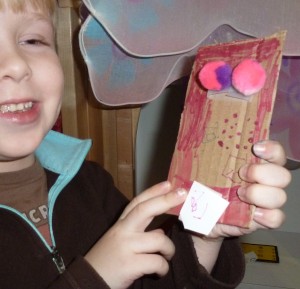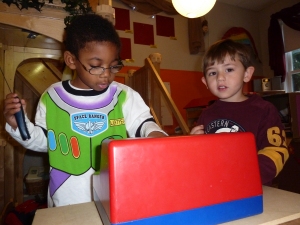One never knows what to expect from lunchtime conversations. Some days, the topics range from magical stories to regaling recent vacations. At other times you might hear discussions on “current events” such as whose birthday party is coming up next or “Do you want to play ‘What Time is it Mr. Fox’ at recess?” It can be quite fun to eavesdrop on the discourse of children.
The conversation circling the lunch table today was a teacher’s dream. Before us was the ideal moment when play, language, child initiative and learning collide. We were still getting food settled on the table when we became aware of the discussion. One of the children was commenting on his family.
“My Daddy is handsome, my Mommy is pretty and I’m handsome, too!”
This lead to a numerical comparison of male and female household members. All participants offered up their gender breakdown. There were connections made, patterns discovered and people counted with 1 to 1 correspondence.
“I have two boys and two girls. One of the boys is my cat.”
This discussion quickly morphed into word play. The children began creating rhymes for their names, practicing letter substitution by replacing the first letter of a name with a new one. Within seconds, members of the group noticed the class names on the window.
“We both have a ‘y’. That’s what is the same!”
And just like that, a single discussion bounced through many learning trajectories.
This entire interaction took no more than six minutes. It involved five children and no adults. (Mrs. Pless and I were watching with rapt attention three feet away, unnoticed by the diners.) Yet, this conversation included more instances of mathematics, literacy language and practice than we could hope for in a teacher led discussion. Not to mention all of the social, emotional and physical practice each student underwent during this short snapshot of lunch.
Children are amazing in their ability to learn. They do so with or without our input. They will practice what they know and push ideas further. Our surprisingly simple job as adults is just to provide them with the tools, be it language or concrete experiences, and support while they grow.
 Beads were one of the many materials we introduced last week. While a small group was creating bracelets, I overheard this conversation regarding the available shapes. (The names are not real.)
Beads were one of the many materials we introduced last week. While a small group was creating bracelets, I overheard this conversation regarding the available shapes. (The names are not real.) this was the very first introduction to beads on the second day of school. We have not had any discussions pertaining to geometric properties or three-dimensional shapes. This is an excellent example of spontaneous peer teaching and learning.
this was the very first introduction to beads on the second day of school. We have not had any discussions pertaining to geometric properties or three-dimensional shapes. This is an excellent example of spontaneous peer teaching and learning.



